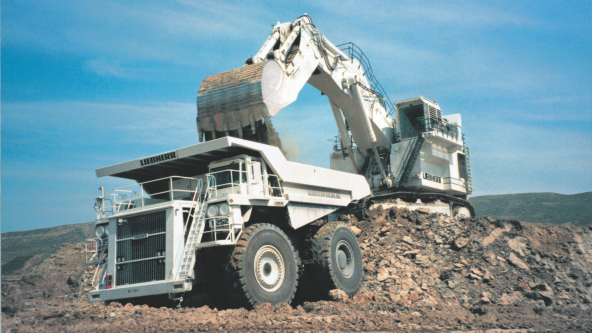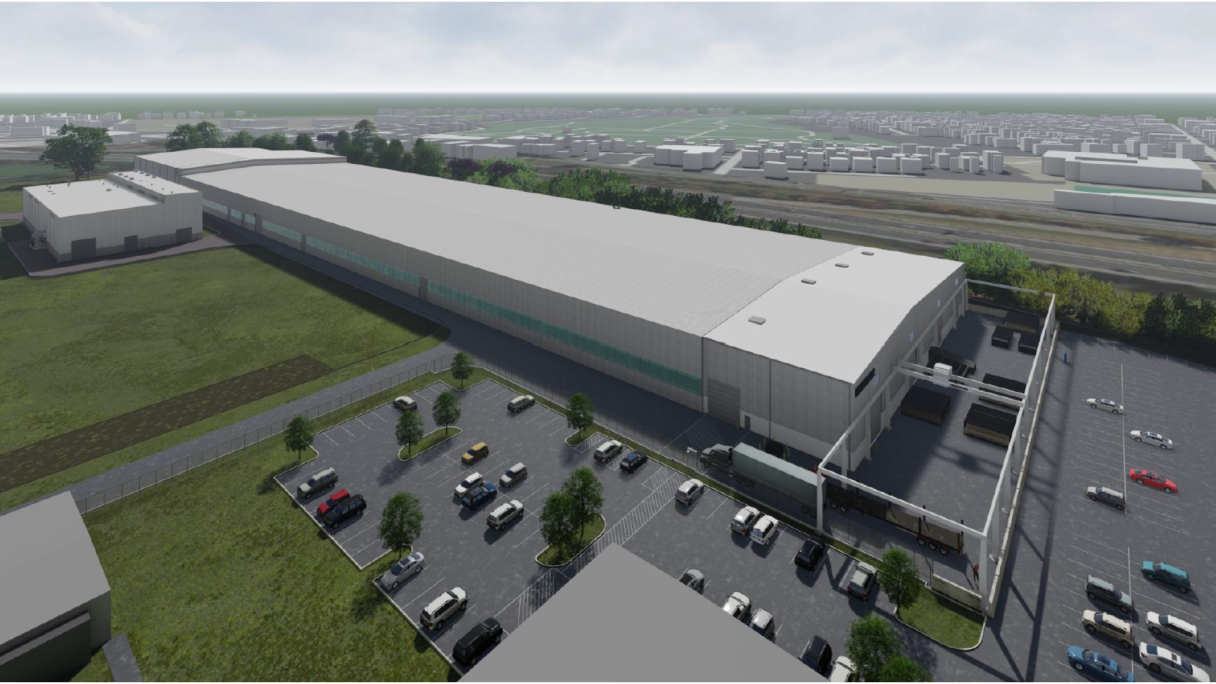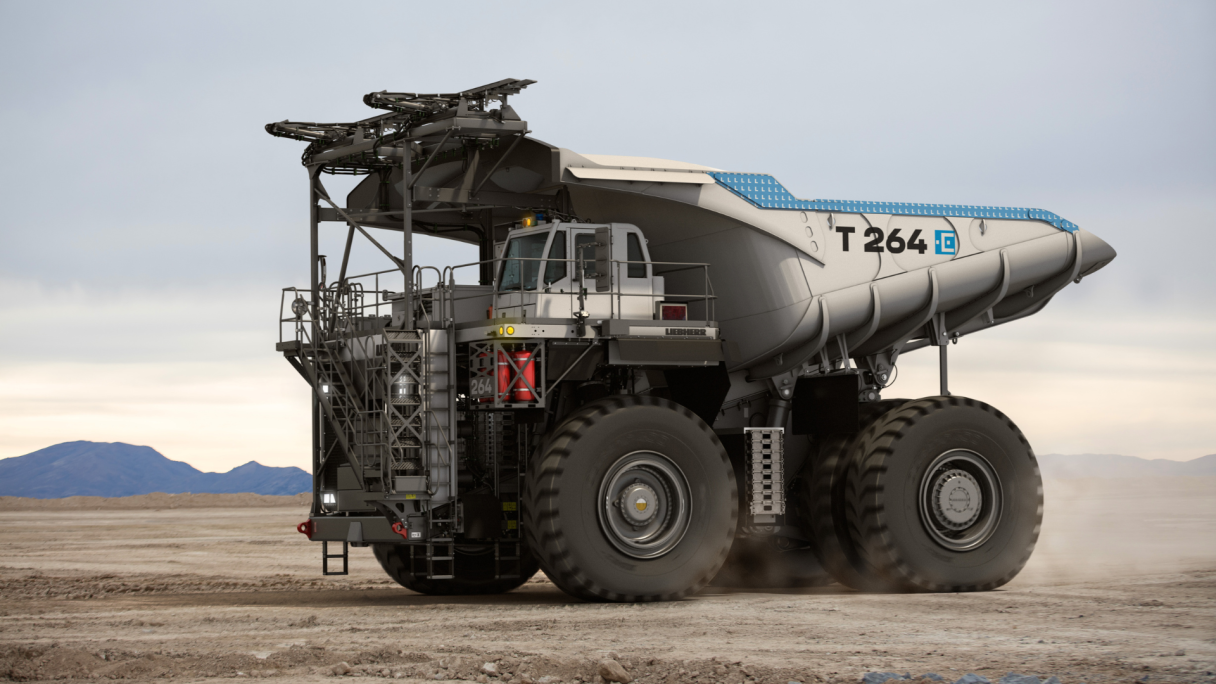30 years of trucking along in Newport News
2025 is a historic year for our truck production facility, Liebherr Mining Equipment Newport News Co.: it’s the factory’s 30th anniversary! To celebrate this momentous occasion, come with us as we explore the past, present and future of Liebherr in Newport News, Virginia, USA!

The KL-2450 was one of two trucks being manufactured by Wiseda when the company was acquired by Liebherr in 1995. It was renamed to T 262 not long after the acquistion.
Liebherr’s foray into mining truck production began in 1995, when the Group acquired Wiseda Ltd. – a North American haul truck manufacturer based in Kansas. At the time, Wiseda was manufacturing two trucks that would eventually become part of Liebherr’s early mining truck portfolio. There was the KL-2420, a 195-tonne (215-ton) haul truck that would become the Liebherr T 252 in 1998. And then there was the KL-2450 – the world’s first two-axle 217-tonne (240 ton), diesel-electric haul truck. This truck was renamed to the T 262 not long after the acquisition. The acquisition of Wiseda, as well as these two trucks, marked the beginning of a new era of Liebherr Mining as we were now able to offer customers solutions to meet their haulage needs as well as their loading and dozing requirements.
For the first twelve months after the acquisition, Liebherr worked from the previous Wiseda facilities in Kansas. However, it wasn’t long before the company decided to move operations to Newport News in Virginia, where Liebherr had been manufacturing crawler excavators for the earthmoving industry since the 1970s. The ‘new’ haul truck production facility was in fact an old manufacturing plant, complete with dirt floors, that had laid dormant for more than 20 years.
Jimmy Pfizenmayer, production supervisor at Liebherr Mining Equipment Newport News Co., has been with the company for 29 years – almost since the very beginning! – and remembers what it was like in those first few years.
‘We only had a small team in the early days. About five people worked the assembly line and maybe ten people worked in fabrication,’ he says.
The facility was officially named Liebherr Mining Equipment Newport News Co. in 1997 and it was that tiny team, toiling away on dirt floors, that laid the foundation for the enormous, state-of-the-art production facility we know today.

The T 252 began its life as the KL-2420 and was another of the trucks manufactured by Wiseda before the acquisition in 1995.
The evolution of Liebherr’s mining trucks
Our T 264 and T 284 haul trucks can trace their lineage all the way back to the very early years of Liebherr Mining Equipment Newport News Co. The predecessor of the T 264, the T 262, was actually one of the very first trucks that we offered after acquiring Wiseda. The progenitor of the T 284, the T 282 C, was introduced a bit later, in 2010. However, the two trucks took two very different journeys to get to where they are today.
Transforming the T 262 into the T 264 we know today was a carefully considered process. After nearly a decade on the market, the 217-tonne capacity truck was discontinued in 2003. The T 252 followed suit not long after and was discontinued in 2004. However, as the years went on, we were seeing growing demand in the market for a slightly larger truck with a 240-tonne payload. The first step towards having a 240-tonne capacity T 262 truck in our portfolio was to adapt the design of the T 262. We updated the frame and the gearsets and also added in the Liebherr Litronic Plus Drive System – all of which gave us a truck with a 220-tonne payload. This first iteration of the T 264 was launched in 2012. But we still hadn’t given up on our ambition of having a 240-tonne truck among our haulage solutions. And so, in 2016, we completely revamped the existing T 264 to reach that coveted 240-tonne capacity. This involved redesigning the suspension and drag links, installing bigger tyres and rims, adding inboard five-calliper brakes on the casings for the new front wheels, integrating a higher horsepower engine with a larger heat rejection radiator, increasing the size of the dump body, increasing the weld geometry in the frame and axle box and changing the planetary gear ratio. Once all of these changes had been completely validated, we started producing the newly minted T 264 – with the 240-tonne payload – in 2017.
The journey from the T 282 to the T 284 of today took a bit longer, and had a few more pitstops, than that of the T 264. The first prototype of the T 282 was built when we still worked out of Wiseda’s Kansas facilities in the 1990s. We took what we learned from this first build and continued to develop the design after we’d relocated to Virginia. The design for the T 282 remained unchanged for the first few years of its life. However, based on customer and operational feedback, we started making changes to improve the performance and efficiency of this ultra-class machine. Over the years, whenever we made major updates to our trucks in the name of continuous improvement, it resulted in new generations of the same truck – even though the design of the overall truck remained the same. This happened twice in the lifespan of the T 282. The first time this happened, and the T 282 B was introduced to the world, was in 2004. The cab of the base machine was upgraded so that it had ROPS and FOPS (roll-over protective structure and falling object protective structure) integrated into its design. A few years later, in 2010, the world was introduced to the T 282 C. This time, the truck had been updated to include the Liebherr Litronic Plus Drive System as well as a new frame, where the lower hoist pin was changed from the mechanically swinging single-shear design of the T 282 B to a double-shear casting design. The final stop on the journey was MINExpo 2012, when the T 284 was unveiled to the world. This new truck now had even more Liebherr-made parts and components integrated into the design of the 363-tonne capacity truck.
Today, our mining trucks can be found on every continent around the world in a wide range of commodities including iron ore, coal, copper and gold. Our global fleet is made up of trucks running with traditional diesel internal combustion engines, on trolley and even one that is powered by hydrogen fuel cells! And in 2025, our battery trucks will begin the validation process, with over 350 of them set to be operational before the end decade. We are also developing a next-generation Autonomous Haulage Solution and will have fleets of autonomous haul trucks operating on site in the near future!
Our mining truck manufacturing facility today
To keep up with the rising demand for our mining trucks, the Liebherr Group will invest a total of US$72.3 million to expand the infrastructure, facilities and personnel at the Newport News factory in order to accommodate the ramping up of production.
‘A lot of exciting work has already been completed here at Newport News!’ exclaims Chris Guilford, general manager, facilities and maintenance, Liebherr Mining Equipment Newport News Co. ‘Construction of our new coating facility finished back in May 2024, which means we can now blast and paint all of the products being built here, rather than needing to outsource. We’ve also been able to increase our shipping capacity by 200 % thanks to the new shipping annex. And, as part of these expansions, we installed three brand new robotic welding machines, bringing us to a grand total of six, as well as a new horizontal milling machine – all of which is helping us to boost our production capacity.’
And there’s even more to come! The front of the manufacturing building is set to expand by more than 1,800 square metres to give the Newport News facility the ability to produce medium-sized parts for our mining trucks like side frames and upper and lower front crosses. The expansion will include a plate preparation system along with a robotic load and unload plasma cutting table.
‘Expanding the factory in this way will ensure we have the capacity and resources to deliver all 360 trucks to Fortescue by the end of the decade while also supporting all of our new and existing customers,’ adds Guilford.

The front of the manufacturing building at the Newport News facility is set to expand by more than 1,800 square metres and will provide the space needed to produce medium-sized parts for Liebherr’s mining trucks.
Adapting to change
‘The progress and change that I see happening is invigorating. In my almost 30 years here, I’ve seen the Newport News facility move from building only small parts with a handful of people to what it is now,’ says Pfizenmayer. ‘I have seen a lot of people come and go but the people that stay, they stay for a long time because they see the potential and growth of the company. Almost two-thirds of my first shift employees have been here for more than twenty years! And now, both my son and son-in-law are working here and learning the business.’
With so many changes on the cards for Liebherr Mining Equipment Newport News Co., it’s important that we support our team in the factory by providing comprehensive training in all of the new processes and procedures. That’s why we’ve expanded the training department at the factory to handle the influx of new people. Plus, our apprenticeship program at the factory is still going strong. The fifth class of this two-year program graduated in October 2024!
Looking ahead
The mining trucks will continue to evolve and get better through the development of new technology. We aim to find different ways to meet market demands, lower customers’ costs and increase productivity with our haulage solutions. One such avenue is to reduce the number of maintenance activities each truck needs when it’s on site. The engineering team is currently looking into ways to make the structures within the trucks lighter and more durable so that they not only need less maintenance during their lifetime but also provide greater efficiency.
Alternative drives and powertrains are also an enormous focus for the future. The team is investigating new and emerging battery technologies that are faster charging, have a longer service life, are more productive and more cost-effective than those currently available. And because of our powertrain-agnostic approach to mining equipment, as well as our modular design philosophy, we will be able to quickly adapt our trucks to these new technologies.

Liebherr battery trucks will begin the validation process in 2025, with over 350 of them set to be operational before the end decade.
Then, of course, there are more conceptual projects that investigate what the future of material haulage could look like. Take the S1 Vision, for example. This is a concept based on the radical idea of stripping a truck all the way down to its most basic components and leaving only what’s necessary for moving material from one place to another. While this is just a concept at this stage, it’s ideas like this that highlight our excitement about the future of what’s possible for our haulage solutions – and the production facility that builds them – moving forward.
‘With such an enormous increase in Liebherr’s truck fleet planned between now and 2030, as well as all the new technology coming our way, Liebherr Mining Equipment Newport News Co is entering an incredibly exciting era of its history,’ says Joshua Brown, general manager, product engineering, Liebherr Mining Equipment Newport News Co. ‘We are unbelievably excited to see what the next 30 years will bring.’
